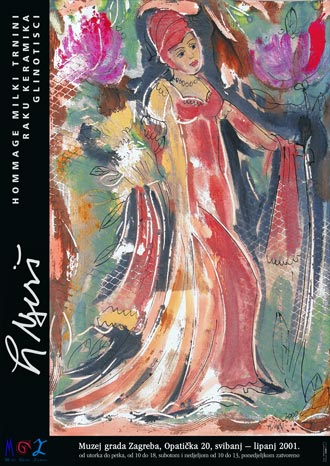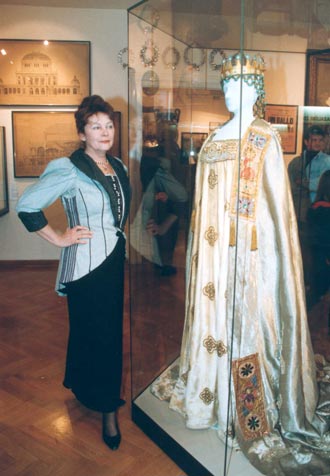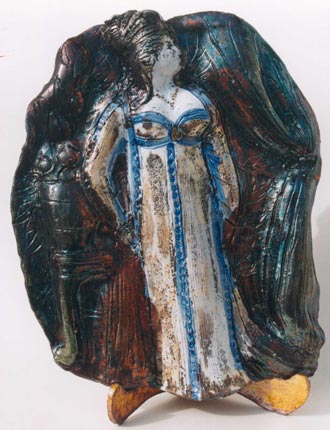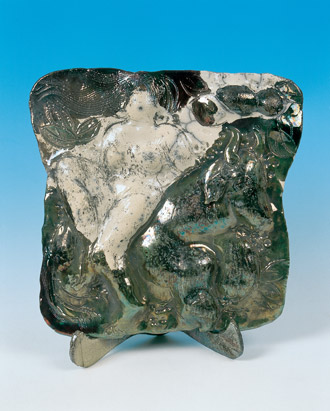Ljerka Njerš – Tribute to Milka Trnina - Raku Ceramics, Clayprints
Exhibition concept: Nada Premerl
Multimedia: Maja Šojat-Bikić, MSc
Exhibition design: Željko Kovačić
Poster design: Miljenko Gregl
 Ljerka Njerš and the Zagreb City Museum
Ljerka Njerš and the Zagreb City Museum
In the last fifteen years, Ljerka Njerš, well-known Croatian painter and potter, has found inspiration for her painting work in the rich holdings of the Zagreb City Museum. She reached intuitively for the past in order consciously to create a new and contemporary form of expression. In 1988 she began to work together with the Museum, deepening her very marked interest in the cultural and historical past of Croatia. Zagreb topics of the 18th and 19th century enforced a series of associations that took on a new value in the creative energy of Ljerka Njerš. Her deliberate investigations led her to cooperate with the Museum. Ljerka’s curiosity and her research into the Museum’s stocks were continued through a much closer and indeed marketing-oriented collaboration with the artist. The Museum helped Ljerka, who had no space for her work, and temporarily assigned her a room in the building at 9 St Mark’s Square (Radić Square as it then was), for her to set up a studio in. This dilapidated old mansion, that the City had acquired for the Museum, had just been taken over by our conservation experts. Research work began – a probe showed interesting murals of the end of the 18th century, fragments of a Baroque portal were found. The mansion suddenly came to life, and living together with the conservators gave Ljerka new stimulus in her current working area. From this room there was a view into a quiet courtyard enhanced by the sounds of stringed instruments – of the Zagreb Soloists, who had even earlier been housed in the courtyard building, in which the first Zagreb radio station had been set up in 1926.
It was in the quiet of this Upper Town mansion that the systematic collaboration between Ljerka Njerš and the ZCM began. First of all, in the Museum, Ljerka discovered all the quality and fascination of the wooden moulds used by the Zagreb gingerbread makers of the 17th and 18th century – used their bas reliefs with their many carved and minute details. In her ceramic interpretation, they took on a new value, a materialised memorial of the spirit and times in which they were created, as Marina Baričević wrote (among other things) about these clay items in connection with the Prize of the 24th Zagreb Salon (1989), in which, in the Proposal Section, Ljerka Njerš and the Zagreb City Msueum were given a prize for souvenirs. This revivified museum item, now in coloured and glazed porcelain, creatively worked by Ljerka Njerš, became a unique souvenir of the Museum and of Zagreb.
 In her search for new themes, in collaboration with the curator of the museum, Ljerka looked for motifs in the collection of views of old Zagreb. Thus, after pictures of Zagreb, a cycle of monotypes was created, which she exhibited in situ in the setting of the palace that had become her home from home. In a house that had been inhabited by many a worthy Zagreb citizen – from Ban Ignjat Gyulay and Dragutin Rakovec to the families of the lawyers Schauff and Cuculić – a new life began. Architect Željko Kovačić, a consultant of the Museum, who was called in to create the display for this exhibition of Ljerka’s, also found it a great challenge. In this historical setting, wanting to use it to the maximum within the context of vision of a new exhibition area in which to interweave the past and the present, he found a suitable framework that breathed the spirit of the time. The murals with their romantic burgs and castles, illusionist paintings on the ceilings, dilapidated walls, still more riddled by the probes of the conservators, created the kind of atmosphere we can imagine in the House of Usher. Here, in this muddle of historical layers, there was also – Ljerka Njerš. Her platters, bowls and plates were exhibited on a round table covered with a tablecloth or on a piano trouvé, or in a wardrobe, the pictures on the new museum construction lived at one with the setting and constituted a value of a new kind. This was best stated by Željko Kovačić in his proposal for the concept of the mounting of the exhibition Hommage to Zagreb. “We do not know what is here part of the past, or the present, or the future. All the ages have intermingled. The old, the present and the future tenants. Is someone moving in or moving out? What is exhibit, and what is the furnishing of the exhibition? But we need not get over-excited by this question. For all of it is Zagreb.”
In her search for new themes, in collaboration with the curator of the museum, Ljerka looked for motifs in the collection of views of old Zagreb. Thus, after pictures of Zagreb, a cycle of monotypes was created, which she exhibited in situ in the setting of the palace that had become her home from home. In a house that had been inhabited by many a worthy Zagreb citizen – from Ban Ignjat Gyulay and Dragutin Rakovec to the families of the lawyers Schauff and Cuculić – a new life began. Architect Željko Kovačić, a consultant of the Museum, who was called in to create the display for this exhibition of Ljerka’s, also found it a great challenge. In this historical setting, wanting to use it to the maximum within the context of vision of a new exhibition area in which to interweave the past and the present, he found a suitable framework that breathed the spirit of the time. The murals with their romantic burgs and castles, illusionist paintings on the ceilings, dilapidated walls, still more riddled by the probes of the conservators, created the kind of atmosphere we can imagine in the House of Usher. Here, in this muddle of historical layers, there was also – Ljerka Njerš. Her platters, bowls and plates were exhibited on a round table covered with a tablecloth or on a piano trouvé, or in a wardrobe, the pictures on the new museum construction lived at one with the setting and constituted a value of a new kind. This was best stated by Željko Kovačić in his proposal for the concept of the mounting of the exhibition Hommage to Zagreb. “We do not know what is here part of the past, or the present, or the future. All the ages have intermingled. The old, the present and the future tenants. Is someone moving in or moving out? What is exhibit, and what is the furnishing of the exhibition? But we need not get over-excited by this question. For all of it is Zagreb.”



 Hommage to Milka Trnina
Hommage to Milka Trnina
The third phase in our collaboration with Ljerka began when the new museum permanent display was organised. Thus the artist was able to see individual items that were familiar to her, but in a new context, which meant that they took on a different dimension. Among other things she discovered the valuable things preserved in the bequest of the famous opera singer Milka Ternina, one of the greatest prima donnas ever to have taken the name of Croatia round the world.
A few of the salient features of her biography follow. She was born in Doljnji Sip near Vezišće in Moslavina, and died in Zagreb in 1941; she spent the last 30 years of her life in Zagreb. She started her career in Zagreb’s old theatre in the Upper Town, appearing in Verdi’s A Masked Ball. She was unable to accept permanent engagement in Zagreb, and set off to obtain experience and fame abroad – in Leipzig, Bremen, Munich, Bayreuth, London and New York. Although more than ninety years have passed since her retirement, her name is still current in the world of music, and in the memories of Zagreb people, as an unsurpassed Wagnerian and dramatic artist.
A considerable part of her legacy is kept in the Zagreb City Museum. The greatest value resides in her rare and splendid costumes for the theatre. These are very particular costumes designed for her by English painter and costume designer Percy Andersen and made in the workshops of Covent Garden during Trnina’s second London period.
 It was these costumes and watercolours (there are 32 of them) that were the inspiration and point of departure for Ljerka for a new cycle of monotypes printed from clay plates.
It was these costumes and watercolours (there are 32 of them) that were the inspiration and point of departure for Ljerka for a new cycle of monotypes printed from clay plates.
The costumes, of course, as interpreted in Ljerka’s clayprints, took on a new dimension. At a distance from the model and yet related with the subject of the fundamental inspiration, they became, in the new painterly interpretation, highly individual pictures breathing a wealth of imagination and a grand feeling for the theatre. Her ladies in elegant costumes were inspired by Trnina’s, which also, however, served as pre-text, one she took over with respect, and which served her imagination as the basis for a new and contemporary form of expression of her own. Ljerka’s experience and rich, lively palette of colours and the mass of details in the structure of the background created fresh and new arabesques and sets of colours. The clayprints are actually one-off creations that Ljerka is exhibiting for the first time at this exhibition. She discovered this technique while studying in England, and has been using it for two years now. The motif is painted on a wet clay plate, and not on a plate of metal or Plexiglas as is usual with the monotype. Ljerka best knows the possibilities for creation in clay, and invested this experience in her work with greasy clay. She puts on painter’s or ceramicist’s paints in lively swirls of colour, and subsequently incises the drawing. The thickness of the application of colour conditions the degree of transparency of the background and the difference in the structure, which Ljerka achieves with various auxiliary tools, with plants or the addition of tissue or netting. From the almost tachistly created backdrops emerge the figures of women clad in various stately costumes, with a mass of details drawn in, a contour drawing incised powerfully into the clay, which on printing appears as a white line, soft like in a linocut. Each picture, from Tosca to Isolda, has been created directly on the clay plate, which has contributed to the freshness of the experience of colour and the sensuality of the work. A great role is also played by the quality of the paper, by its ability to absorb paint, because Ljerka prints her monotypes directly onto it, with the assistance of a roller. Sometimes she makes subsequent alterations and additions with ink drawing or additional paint.
 I would like to draw particular attention to the reliefs that the artist has done, showing for the first time in ceramics powerfully modelled erotic scenes (nudes and couples in love), their plasticity highlighted by the white of the glaze. Among these reliefs there are two that present Milka Trnina in a theatrical context.
I would like to draw particular attention to the reliefs that the artist has done, showing for the first time in ceramics powerfully modelled erotic scenes (nudes and couples in love), their plasticity highlighted by the white of the glaze. Among these reliefs there are two that present Milka Trnina in a theatrical context.
The freedom of her imagination is enriched by this invocation of the past and the homage done to Trnina and her costumes, all a sign of the enormous respect in which this great Croatian opera singer is held.
As well as Hommage to Trnina, there will be several female nudes, also done as monotypes in the clayprint technique. These are semi-reclining figures attractively located in a chromatically vibrant space, rich in vegetation, that of Ljerka’s personal pastoral, which is so typical of her work.
Nada Premerl
 Raku Ceramics in the Work of Ljerka Njerš
Raku Ceramics in the Work of Ljerka Njerš
In the ceramic work of Ljerka Njerš, we can observe a sequence of several creative cycles in which the artist has always endeavoured to find new means to express herself in her art and to investigate new possibilities of the clay that she has used during her work. In the long-term path of development, and in the ongoing changes of her approach to the creative process of working in ceramics, we can today sense the artist’s highly refined feeling for the decorative, and her deeply felt painterly approach to each individual work.
As well as the clay that is the basic medium for her expression, Ljerka Njerš makes abundant use of drawing and colour, which she uses to enrich the surface of her ceramic forms. This part of her work should not be considered a mere decorative addition to the form, but a logical and integral characteristic of the work. In her works, drawing derives from form, with which it merges, and it is through this merging and suffusion that the artist knows the fullness of her very personal form of artistic expression. In the earlier works of Ljerka Njerš a firm connection with the ceramic tradition of the milieu in which she grew up can be seen. It was in this tradition that her oeuvre of utilitarian ceramics developed – bowls, platters and vases. She enhanced the basic forms of these items with drawings of an extremely refined harmony of colouring. In this part of her work, we can see recognisable motifs to which she remained faithful for many a year. These are landscape and flower themes, and, as well as them, like inevitable signposts, female nudes composed with a refined play of flat drawing. However, during her life’s journey devoted to ceramics, in her search for ever-new possibilities in the construction of the ceramic form, Ljerka Njerš was to free herself from the inheritance in which the purpose of an item of ceramics was the basic, set purpose in the vivification of the creative ideas of the artist. This journey was neither rapid nor easy, and was marked by long lasting considerations and quests. In a later period of her work, use-items were to remain within the sphere of her interests. However, the artist now interpreted and experienced them in a different way. They remained a pretext and an inspiration in the construction of the ceramic form that had no real use function, and with this kind of idea the artist was to attain new aesthetic values in the framing of each individual work.
 In the multiplicity of her research into ceramics, in recent years Ljerka Njerš has directed her attention to studying and applying the ancient ceramic technique known as raku, the source of which, in the distant past, was in Japan. Ljerka Njerš found in the basic premises of this very individual ceramic art ideal possibilities to adopt the technique to the needs of her own form of artistic expression. This resulted in the artist’s most recent cycle, in which there are works of a completely new kind of manner of handling the ceramic material, as well as new and hitherto unapplied interpretations of ceramic forms. The art of the Far East has for centuries enthralled Europe with its creations; in many periods of history it has had an enhancing impact on numerous European works of art. The eye of the careful observer will see these influences in the earlier works of Ljerka Njerš as well, particularly in the landscapes of a reduced flat drawing in dark shades that the artist constructs in glazes on a flat, sometimes even curved ceramic surface. Today, using the raku technique, her recent, still highly individual, works have achieved a new level of expressiveness, and it would seem that this ancient ceramic technique has breathed new spirit into them.
In the multiplicity of her research into ceramics, in recent years Ljerka Njerš has directed her attention to studying and applying the ancient ceramic technique known as raku, the source of which, in the distant past, was in Japan. Ljerka Njerš found in the basic premises of this very individual ceramic art ideal possibilities to adopt the technique to the needs of her own form of artistic expression. This resulted in the artist’s most recent cycle, in which there are works of a completely new kind of manner of handling the ceramic material, as well as new and hitherto unapplied interpretations of ceramic forms. The art of the Far East has for centuries enthralled Europe with its creations; in many periods of history it has had an enhancing impact on numerous European works of art. The eye of the careful observer will see these influences in the earlier works of Ljerka Njerš as well, particularly in the landscapes of a reduced flat drawing in dark shades that the artist constructs in glazes on a flat, sometimes even curved ceramic surface. Today, using the raku technique, her recent, still highly individual, works have achieved a new level of expressiveness, and it would seem that this ancient ceramic technique has breathed new spirit into them.
In old Japan, raku ceramics developed as part of a philosophic way of thinking about life, closely connected with the tea ceremony. Naturalness of form and the individual character of each item were particularly valued by the tea ceremony masters, and raku became an essential determinant of such social occasions, and with its meditative purpose reflected both the way of thinking and the lifestyle of its age. There were several reasons, even practical ones, that led to this ceramic style becoming such a favour in everyday life as well. The dense, porous walls of the vessels kept the warmth of the tea, and the rough, grainy surface of the individually-made forms gave the hands of those taking part in the ceremony a pleasant tactile sensation.
 In the technological characteristics of raku ware, Ljerka Njerš has recognised characteristics in accordance with her own aspirations aimed at further enhancement of her ceramic expression. The possibilities that this technique offered, and the effects that can be achieved by applying it in the process of the creation of a work of ceramics, were challenge enough for Ljerka Njerš to want to try out this area of ceramic formation as well. The individuality of the raku technique inheres in the effects that come into being with the reduction of the metal oxides after the freshly fired glazed object is packed with sawdust and then plunged into cold water. And just as the finished products, in their form and their grainy surface, offer not only an aesthetic but also a tactile experience, so during the process in which they are made, they also give anyone taking part in the process a certain creative joy instinct with enigmatic expectation. The ceramic forms that Ljerka Njerš presents us in her new cycle nevertheless display the individual stamp of the artist’s creativity. There are vessels, plates and tablets with painted motifs of nudes, and a novelty in this group of exhibits – reliefs that we have so far not had occasion to meet in her oeuvre. However, in accordance with the implementation of a new technique, the interpretation of the forms is different, and also different is the experience that the items evoke in the observer. The artist covers a white tile with transparent or white glaze, and attains highly marked effects with the reduction of metal oxides applied to the ceramic surface. In this procedure, powerful accents of a metal shine are created on the object, which with the tactilely appealing grainy surface most of all contribute to the beauty of the experience of raku. We do not, however, experience these shining accents as arising from the mere desire of the artist to achieve external effects. What is more, just as ceramic drawing as interpreted by Ljerka Njerš makes up an organic whole with the object and is no mere decoration, so we take the areas of metallic glitter on the artist’s raku creations as integral characteristics of the organic merging of the thing created in the creative process. In the composition of these recent works, Ljerka Njerš remains true to the application of textile ornamentation, and these motifs printed into the clay follow, with their living rhythm, the forms of the ceramic objects.
In the technological characteristics of raku ware, Ljerka Njerš has recognised characteristics in accordance with her own aspirations aimed at further enhancement of her ceramic expression. The possibilities that this technique offered, and the effects that can be achieved by applying it in the process of the creation of a work of ceramics, were challenge enough for Ljerka Njerš to want to try out this area of ceramic formation as well. The individuality of the raku technique inheres in the effects that come into being with the reduction of the metal oxides after the freshly fired glazed object is packed with sawdust and then plunged into cold water. And just as the finished products, in their form and their grainy surface, offer not only an aesthetic but also a tactile experience, so during the process in which they are made, they also give anyone taking part in the process a certain creative joy instinct with enigmatic expectation. The ceramic forms that Ljerka Njerš presents us in her new cycle nevertheless display the individual stamp of the artist’s creativity. There are vessels, plates and tablets with painted motifs of nudes, and a novelty in this group of exhibits – reliefs that we have so far not had occasion to meet in her oeuvre. However, in accordance with the implementation of a new technique, the interpretation of the forms is different, and also different is the experience that the items evoke in the observer. The artist covers a white tile with transparent or white glaze, and attains highly marked effects with the reduction of metal oxides applied to the ceramic surface. In this procedure, powerful accents of a metal shine are created on the object, which with the tactilely appealing grainy surface most of all contribute to the beauty of the experience of raku. We do not, however, experience these shining accents as arising from the mere desire of the artist to achieve external effects. What is more, just as ceramic drawing as interpreted by Ljerka Njerš makes up an organic whole with the object and is no mere decoration, so we take the areas of metallic glitter on the artist’s raku creations as integral characteristics of the organic merging of the thing created in the creative process. In the composition of these recent works, Ljerka Njerš remains true to the application of textile ornamentation, and these motifs printed into the clay follow, with their living rhythm, the forms of the ceramic objects.
Although far from its origins in the manner of thinking of the Japan of yesteryear, the raku ceramic ware of Ljerka Njerš provides today’s people an abundance of new aesthetic experiences, and opens up new paths of creativity to the artist for the years to come.
Stanko Staničić
Pictures from the exhibition


 Exhibition catalogue
Exhibition catalogue
Premerl, Nada; Stanko Staničić. Ljerka Njerš : Hommage a Milka Trnina : Raku ceramics, clayprints.
Zagreb : Zagreb City Museum, 2001

